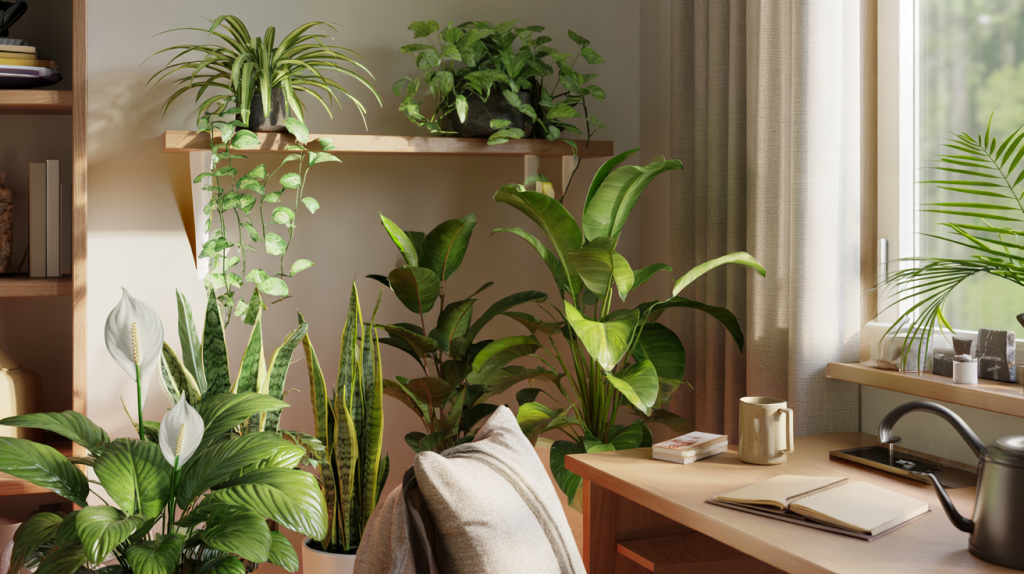Stale room, busy mind, low energy. Indoor plants change that picture faster than a new coat of paint. Research links greenery to lower stress, sharper focus, steadier humidity and even nicer acoustics. Offices with plants showed a 15 percent productivity lift in a University of Exeter study published in 2014, while lab work in the Journal of Physiological Anthropology in 2015 found lower blood pressure and calmer nerves after simple tasks with plants.
Air purifying claims deserve context. NASA tests in 1989 showed certain plants remove volatile organic compounds in sealed chambers, yet a 2019 review by Michael Waring at Drexel University reported you would need dozens to thousands of plants per square meter to match ordinary ventilation. So the big wins at home come from wellbeing, small improvements in air and the daily cue that nature is close.
Benefits of indoor plants that you feel and measure
Work and study performance often improves when rooms get greener. In field trials across the United Kingdom and the Netherlands, the 2014 University of Exeter team reported that plant enriched offices boosted productivity by 15 percent. The explanation is not just vibe. Visual micro breaks, softer noise, a touch of biophilic design all stack up during the day.
Stress and mood respond quickly. A University of Technology Sydney project in 2010 tracked workers and saw tension and anxiety fall by 37 percent, depression by 58 percent, anger by 44 percent and fatigue by 38 percent after plants arrived. A small 2015 experiment in the Journal of Physiological Anthropology showed a drop in sympathetic nervous activity and a lower pulse after a brief interaction with plants compared with a computer task.
Air feels easier to breathe when carbon dioxide peaks are tamed. Multiple office trials led by University of Technology Sydney reported indoor plants cutting CO2 by roughly 10 percent in air conditioned buildings and about 25 percent in naturally ventilated rooms. Add humidity and the comfort story gets stronger. ASHRAE places the sweet spot for indoor relative humidity at 30 to 60 percent, and foliage gently nudges dry winter air toward that range through transpiration.
What to fix first : the problems that cancel the benefits
Wrong plant in wrong light is the classic trap. A shade plant parked on a sunny sill will scorch, while a light hungry species languishes in a dim hallway. The result is dull leaves, slow growth and zero wellbeing lift.
Overwatering causes most complaints. Constantly wet soil invites fungus gnats and mold, and that undercuts any air or mood benefit. Let the top couple of centimeters dry for most species before watering again, and use pots with drainage.
Crowding plants without airflow raises humidity around leaves and can push spores into the room. Spread them out, clean dust from foliage to keep photosynthesis working, and rotate pots for even growth. Households with pets need one more filter. Many popular plants are toxic if chewed. The American Society for the Prevention of Cruelty to Animals maintains clear lists of safe and unsafe species, so check names before buying.
Best indoor plants and what they really do
Looking for low effort wins with credible upsides and minimal risk It comes down to sturdy, adaptable species that tolerate typical apartments and offices.
- Snake plant “Sansevieria” : tough in low to medium light, gentle CO2 buffering at night, minimal watering.
- Spider plant “Chlorophytum comosum” : resilient, kid friendly, grows fast and helps smooth CO2 peaks.
- Pothos “Epipremnum aureum” : trails nicely, thrives in mixed light, simple to propagate so your green zone can expand.
- Peace lily “Spathiphyllum” : visual calm with occasional blooms, likes evenly moist soil and medium light.
- Rubber plant “Ficus elastica” : larger leaves dampen sound a bit and add presence in living rooms.
- Areca palm “Dypsis lutescens” : steady transpiration that can nudge dry rooms toward comfort in winter.
How to start today and keep the benefits next month
Map the light first. Morning sun near an east window suits a peace lily or pothos, bright indirect corners welcome a rubber plant, and that dim shelf wants a snake plant. No guesswork, just observe light for a day.
Water on a rhythm, not a calendar. Touch the soil, then water deeply and let excess drain. Pair this with a simple saucer and a breathable potting mix so roots get air. A small moisture meter helps new plant parents avoid overdoing it.
Track the room environment. If winter humidity drops below 30 percent, group a couple of plants on a tray of pebbles with water below the pot bottoms. That raises local humidity without drenching roots. Keep indoor relative humidity under 60 percent to stay within ASHRAE comfort guidance.
Stay realistic about air cleaning. Plants offer benefical side effects for CO2 and microclimate, yet ventilation remains the main lever for pollutants. Open a window when outdoor air is good, or run mechanical ventilation or a certified air purifier for smoke and fine particles. Plants then do what they excel at in daily life : calming the mind, softening hard corners and turning a room into a place people actually enjoy.
